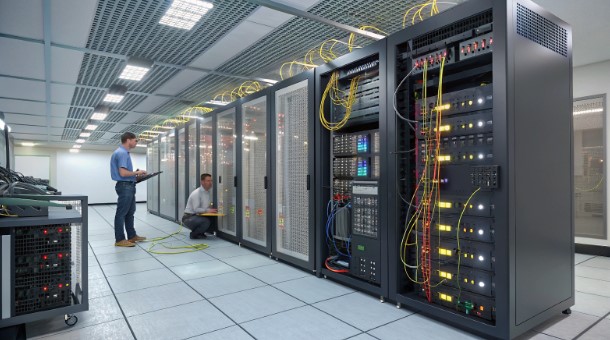How to Choose Overseas Large Server Storage in AI Era?

In the rapidly evolving landscape of artificial intelligence, selecting the right enterprise storage solution has become a critical decision for tech organizations. Whether you’re running intensive machine learning workloads or managing vast datasets for AI training, the choice between server hosting and colocation solutions can significantly impact your operation’s success. This comprehensive guide dives deep into the technical specifications and architectural considerations for enterprise-grade storage infrastructure.
Technical Requirements for AI Storage Infrastructure
Modern AI workloads demand exceptional I/O performance and storage capabilities that surpass traditional enterprise requirements. Let’s examine the core technical specifications necessary for robust AI operations:
- Sequential Read/Write Speeds: Minimum 10GB/s for large dataset processing
- IOPS Requirements: 100,000+ IOPS for concurrent AI operations
- Network Bandwidth: 400Gbps connectivity for distributed training
- Storage Capacity: Scalable architecture supporting petabyte-scale data
Storage Architecture Patterns for AI Workloads
Enterprise storage architecture for AI applications typically follows specific patterns optimized for performance and scalability:
├── Hot Tier (NVMe Storage)
│ ├── Active Training Data
│ └── Real-time Inference
├── Warm Tier (SSD Arrays)
│ ├── Recent Datasets
│ └── Model Checkpoints
└── Cold Tier (HDD Storage)
├── Historical Data
└── Archived Models
Performance Benchmarking and Infrastructure Analysis
When evaluating enterprise storage solutions, performance metrics serve as critical decision factors. Here’s a technical breakdown of key performance indicators:
# Performance Matrix |--------------------|------------|--------------| | Storage Type | Latency | Throughput | |--------------------|------------|--------------| | NVMe over TCP | ~100μs | 40GB/s | | NVMe over FC | ~50μs | 32GB/s | | All-Flash Array | ~500μs | 20GB/s | | Hybrid Storage | ~2ms | 10GB/s | |--------------------|------------|--------------|
Distributed Storage Architectures
Modern AI workloads benefit from distributed storage architectures that optimize data locality and reduce I/O bottlenecks. Consider this architectural pattern:
- Edge Caching Layer: Local NVMe cache for immediate access
- Distribution Layer: Sharded data across multiple nodes
- Persistence Layer: Redundant storage with error correction
- Management Layer: Automated resource allocation and scaling
Cost-Performance Analysis for Enterprise Solutions
Understanding the TCO (Total Cost of Ownership) requires analyzing various components:
Component Analysis: - Hardware Costs: $0.10-0.15 per GB/month (NVMe) - Network Bandwidth: $0.05-0.08 per GB transferred - Power Consumption: 1.2-1.5 kW per rack - Cooling Requirements: PUE 1.2-1.3 - Management Overhead: ~20% of infrastructure costs
Implementation Best Practices
Here’s a technical implementation checklist for enterprise AI storage:
- Configure RAID with attention to stripe size optimization
- Implement automatic tiering based on access patterns
- Deploy monitoring systems with sub-millisecond precision
- Establish backup protocols with RPO < 15 minutes
- Configure network QoS for predictable performance
Security and Compliance Considerations
Enterprise AI storage demands robust security protocols. Implement these security measures in your infrastructure:
# Security Implementation Matrix
├── Data-at-Rest Protection
│ ├── AES-256 encryption
│ └── Hardware security modules
├── Data-in-Transit Security
│ ├── TLS 1.3 protocols
│ └── VPN tunneling
└── Access Control
├── RBAC implementation
└── MFA enforcement
Performance Optimization Techniques
Maximize your storage infrastructure with these technical optimizations:
- Enable multi-queue block layer (blk-mq)
- Optimize TCP/IP stack parameters:
net.core.rmem_max = 16777216 net.core.wmem_max = 16777216 net.ipv4.tcp_rmem = 4096 87380 16777216 net.ipv4.tcp_wmem = 4096 65536 16777216 - Configure appropriate I/O schedulers for NVMe devices
- Implement proper NUMA alignment for multi-socket systems
Future-Proofing Your Infrastructure
Consider these emerging technologies for long-term scalability:
- CXL-based memory expansion
- Computational storage devices
- Gen-Z fabric connectivity
- AI-optimized file systems
Conclusion
Selecting the right enterprise storage solution for AI workloads requires careful consideration of performance metrics, architecture patterns, and cost implications. Whether opting for hosting or colocation solutions, ensure your infrastructure can scale with advancing AI requirements. The future of AI storage lies in distributed architectures, specialized hardware acceleration, and intelligent data management systems.

